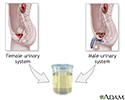Urine culture
Culture and sensitivity - urineA urine culture is a lab test to check for bacteria or other germs in a urine sample.
It can be used to check for a urinary tract infection in adults and children.
Adults
A urinary tract infection, or UTI, is an infection of the urinary tract. The infection can occur at different points in the urinary tract, including...

Children
A urinary tract infection is a bacterial infection of the urinary tract. This article discusses urinary tract infections in children. The infection ...

How the Test is Performed
Most of the time, the sample will be collected as a clean catch urine sample in your health care provider's office or your home. You will use a special kit to collect the urine.
Clean catch urine sample
A clean catch is a method of collecting a urine sample to be tested. The clean-catch urine method is used to prevent germs from the penis or vagina ...
Read Article Now Book Mark ArticleA urine sample can also be taken by inserting a thin rubber tube (catheter) through the urethra into the bladder. This is done by someone in your provider's office or at the hospital. The urine drains into a sterile container, and the catheter is removed.
Rarely, your provider may collect a urine sample by inserting a needle through the skin of your lower abdomen into your bladder.
The urine is taken to a lab to determine which, if any, bacteria or yeast are present in the urine. This takes 24 to 48 hours.
How to Prepare for the Test
If possible, collect the sample when urine has been in your bladder for 2 to 3 hours.
How the Test will Feel
When the catheter is inserted, you may feel pressure. A special gel is used to numb the urethra.
Why the Test is Performed
Your provider may order this test if you have symptoms of a urinary tract infection or bladder infection, such as pain or burning when urinating.
Urinary tract infection
A urinary tract infection, or UTI, is an infection of the urinary tract. The infection can occur at different points in the urinary tract, including...

You also may have a urine culture after you have been treated for an infection. This is to make sure that all of the bacteria are gone.
Normal Results
"Normal growth" is a normal result. This means that there is no infection.
Normal value ranges may vary slightly among different laboratories. Some labs use different measurements or test different samples. Talk to your provider about the meaning of your specific test results.
What Abnormal Results Mean
A "positive" or abnormal test is when bacteria or yeast are found in the culture. This likely means that you have a urinary tract infection or bladder infection.
Other tests may help your provider know which bacteria or yeast are causing the infection and which antibiotics will best treat it, if treatment is needed.
Sometimes more than one type of bacteria, or only a small amount, may be found in the culture.
Risks
There is a very rare risk for a hole (perforation) in the urethra or bladder if your provider uses a catheter.
Considerations
You may have a false-negative urine culture if you have been taking antibiotics.
References
Cooper KL, Badalato GM, Rutman MP. Infections of the urinary tract. In: Partin AW, Dmochowski RR, Kavoussi LR, Peters CA, eds. Campbell-Walsh-Wein Urology. 12th ed. Philadelphia, PA: Elsevier; 2021:chap 55.
Nicolle LE, Drekonja D. Approach to the patient with urinary tract infections. In: Goldman L, Schafer AI, eds. Goldman-Cecil Medicine. 26th ed. Philadelphia, PA: Elsevier; 2020:chap 268.
-
Urinary tract infection - adults
Animation
-
Urine sample - illustration
A clean-catch urine sample is performed by collecting the sample of urine in midstream. Men or boys should wipe clean the head of the penis. Women or girls need to wash the area between the lips of the vagina with soapy water and rinse well. A small amount of urine should initially fall into the toilet bowl before it is collected (this clears the urethra of contaminants). Then, in a clean container, catch about 1 to 2 ounces of urine and remove the container from the urine stream. The container is then given to the health care provider.
Urine sample
illustration
-
Female urinary tract - illustration
The female and male urinary tracts are relatively the same except for the length of the urethra.
Female urinary tract
illustration
-
Male urinary tract - illustration
The male and female urinary tracts are relatively the same except for the length of the urethra.
Male urinary tract
illustration
-
Urine sample - illustration
A clean-catch urine sample is performed by collecting the sample of urine in midstream. Men or boys should wipe clean the head of the penis. Women or girls need to wash the area between the lips of the vagina with soapy water and rinse well. A small amount of urine should initially fall into the toilet bowl before it is collected (this clears the urethra of contaminants). Then, in a clean container, catch about 1 to 2 ounces of urine and remove the container from the urine stream. The container is then given to the health care provider.
Urine sample
illustration
-
Female urinary tract - illustration
The female and male urinary tracts are relatively the same except for the length of the urethra.
Female urinary tract
illustration
-
Male urinary tract - illustration
The male and female urinary tracts are relatively the same except for the length of the urethra.
Male urinary tract
illustration
Review Date: 10/20/2022
Reviewed By: Linda J. Vorvick, MD, Clinical Professor, Department of Family Medicine, UW Medicine, School of Medicine, University of Washington, Seattle, WA. Also reviewed by David C. Dugdale, MD, Medical Director, Brenda Conaway, Editorial Director, and the A.D.A.M. Editorial team.






